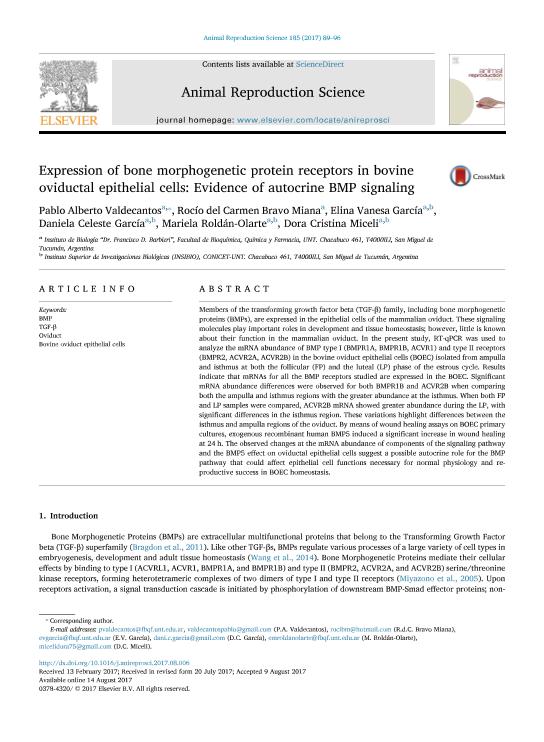Mostrar el registro sencillo del ítem
dc.contributor.author
Valdecantos, Pablo Alberto

dc.contributor.author
Bravo Miana, Rocío del Carmen

dc.contributor.author
Garcia, Elina Vanesa

dc.contributor.author
Garcia, Daniela Celeste

dc.contributor.author
Roldan Olarte, Eugenia Mariela

dc.contributor.author
Miceli, Dora Cristina

dc.date.available
2018-08-01T20:58:11Z
dc.date.issued
2017-10
dc.identifier.citation
Valdecantos, Pablo Alberto; Bravo Miana, Rocío del Carmen; Garcia, Elina Vanesa; Garcia, Daniela Celeste; Roldan Olarte, Eugenia Mariela; et al.; Expression of bone morphogenetic protein receptors in bovine oviductal epithelial cells: Evidence of autocrine BMP signaling; Elsevier Science; Animal Reproduction Science; 185; 10-2017; 89-96
dc.identifier.issn
0378-4320
dc.identifier.uri
http://hdl.handle.net/11336/53840
dc.description.abstract
Members of the transforming growth factor beta (TGF-β) family, including bone morphogenetic proteins (BMPs), are expressed in the epithelial cells of the mammalian oviduct. These signaling molecules play important roles in development and tissue homeostasis; however, little is known about their function in the mammalian oviduct. In the present study, RT-qPCR was used to analyze the mRNA abundance of BMP type I (BMPR1A, BMPR1B, ACVR1) and type II receptors (BMPR2, ACVR2A, ACVR2B) in the bovine oviduct epithelial cells (BOEC) isolated from ampulla and isthmus at both the follicular (FP) and the luteal (LP) phase of the estrous cycle. Results indicate that mRNAs for all the BMP receptors studied are expressed in the BOEC. Significant mRNA abundance differences were observed for both BMPR1B and ACVR2B when comparing both the ampulla and isthmus regions with the greater abundance at the isthmus. When both FP and LP samples were compared, ACVR2B mRNA showed greater abundance during the LP, with significant differences in the isthmus region. These variations highlight differences between the isthmus and ampulla regions of the oviduct. By means of wound healing assays on BOEC primary cultures, exogenous recombinant human BMP5 induced a significant increase in wound healing at 24 h. The observed changes at the mRNA abundance of components of the signaling pathway and the BMP5 effect on oviductal epithelial cells suggest a possible autocrine role for the BMP pathway that could affect epithelial cell functions necessary for normal physiology and reproductive success in BOEC homeostasis.
dc.format
application/pdf
dc.language.iso
eng
dc.publisher
Elsevier Science

dc.rights
info:eu-repo/semantics/openAccess
dc.rights.uri
https://creativecommons.org/licenses/by-nc-sa/2.5/ar/
dc.subject
Bmp
dc.subject
Bovine Oviduct Epithelial Cells
dc.subject
Oviduct
dc.subject
Tgf-Β
dc.subject.classification
Otras Ciencias Biológicas

dc.subject.classification
Ciencias Biológicas

dc.subject.classification
CIENCIAS NATURALES Y EXACTAS

dc.title
Expression of bone morphogenetic protein receptors in bovine oviductal epithelial cells: Evidence of autocrine BMP signaling
dc.type
info:eu-repo/semantics/article
dc.type
info:ar-repo/semantics/artículo
dc.type
info:eu-repo/semantics/publishedVersion
dc.date.updated
2018-07-30T13:48:55Z
dc.journal.volume
185
dc.journal.pagination
89-96
dc.journal.pais
Países Bajos

dc.journal.ciudad
Amsterdam
dc.description.fil
Fil: Valdecantos, Pablo Alberto. Universidad Nacional de Tucumán. Facultad de Bioquímica, Química y Farmacia. Instituto de Biología; Argentina
dc.description.fil
Fil: Bravo Miana, Rocío del Carmen. Consejo Nacional de Investigaciones Científicas y Técnicas. Centro Científico Tecnológico Conicet - Tucumán. Instituto Superior de Investigaciones Biológicas. Universidad Nacional de Tucumán. Instituto Superior de Investigaciones Biológicas; Argentina. Universidad Nacional de Tucumán. Facultad de Bioquímica, Química y Farmacia. Instituto de Biología; Argentina
dc.description.fil
Fil: Garcia, Elina Vanesa. Consejo Nacional de Investigaciones Científicas y Técnicas. Centro Científico Tecnológico Conicet - Tucumán. Instituto Superior de Investigaciones Biológicas. Universidad Nacional de Tucumán. Instituto Superior de Investigaciones Biológicas; Argentina. Universidad Nacional de Tucumán. Facultad de Bioquímica, Química y Farmacia. Instituto de Biología; Argentina
dc.description.fil
Fil: Garcia, Daniela Celeste. Consejo Nacional de Investigaciones Científicas y Técnicas. Centro Científico Tecnológico Conicet - Tucumán. Instituto Superior de Investigaciones Biológicas. Universidad Nacional de Tucumán. Instituto Superior de Investigaciones Biológicas; Argentina. Universidad Nacional de Tucumán. Facultad de Bioquímica, Química y Farmacia. Instituto de Biología; Argentina
dc.description.fil
Fil: Roldan Olarte, Eugenia Mariela. Consejo Nacional de Investigaciones Científicas y Técnicas. Centro Científico Tecnológico Conicet - Tucumán. Instituto Superior de Investigaciones Biológicas. Universidad Nacional de Tucumán. Instituto Superior de Investigaciones Biológicas; Argentina. Universidad Nacional de Tucumán. Facultad de Bioquímica, Química y Farmacia. Instituto de Biología; Argentina
dc.description.fil
Fil: Miceli, Dora Cristina. Consejo Nacional de Investigaciones Científicas y Técnicas. Centro Científico Tecnológico Conicet - Tucumán. Instituto Superior de Investigaciones Biológicas. Universidad Nacional de Tucumán. Instituto Superior de Investigaciones Biológicas; Argentina. Universidad Nacional de Tucumán. Facultad de Bioquímica, Química y Farmacia. Instituto de Biología; Argentina
dc.journal.title
Animal Reproduction Science

dc.relation.alternativeid
info:eu-repo/semantics/altIdentifier/url/https://www.sciencedirect.com/science/article/pii/S0378432017301215
dc.relation.alternativeid
info:eu-repo/semantics/altIdentifier/doi/https://doi.org/10.1016/j.anireprosci.2017.08.006
Archivos asociados
